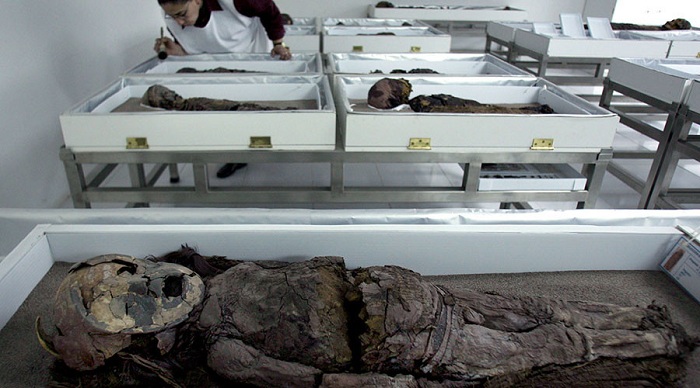The Chinchorro were a hunting and fishing people who lived from 10,000 to 3,400 BC on the Pacific coast of South America, at the edge of the Atacama desert.
They were among the first people in the world to mummify their dead. Their mummies date back some 7,400 years -- at least 2,000 years older than Egypt`s.
Now, researchers are hoping to use modern medical technology to reconstruct what they looked like in life, decode their genes and better understand the mysteries of this ancient civilization.
The 15 Chinchorro mummies, mostly children and unborn babies, were put through a CT scanner at the Los Condes clinic in the Chilean capital.
"We collected thousands of images with a precision of less than one millimeter," said chief radiologist Marcelo Galvez.
"The next phase is to try to dissect these bodies virtually, without touching them, which will help us preserve them for another 500,000 years."
Using high-tech computer processing, researchers are busy reconstructing the mummies` muscles and facial features.
"We want to see what they physically looked like, to reconstruct them and bring to life someone who died thousands of years ago," said Galvez.
Researchers are also hoping to learn more about how the Chinchorro mummified their dead.
The Chinchorro, who apparently had a complex understanding of human anatomy, would carefully remove the skin and muscles of the deceased.
Using wood, plants and clay, they reconstructed the body around the remaining skeleton, then sewed the original skin back on, adding a mouth, eyes and hair.
A mask was then placed over the face.
The result looks like something in between a statue and a person -- eerily lifelike even after thousands of years.
- All in the family -
Mummification was an intimate process for the Chinchorro, said Veronica Silva, the head of the anthropology department at Chile`s National Museum of Natural History.
"The family itself would make the mummy," she told AFP.
The earliest mummies were unborn fetuses and newborns, she said.
The mummies were all made using the same basic process, but each one shows unique "technological and artistic innovations," she said.
It was a process that evolved over time. The newest mummies are the most elaborate.
Some 180 Chinchorro mummies have been discovered since 1903.
All were found outdoors, placed near the beach. The Chinchorro apparently did not build pyramids or any other structures to house them.
In fact, the Chinchorro civilization left no trace besides its mummies.
"We are effectively talking about the oldest artificially mummified bodies in the world," said Silva.
"The Chinchorro mummies date to 7,400 years ago. That is to say, this system... existed 2,000 years before the first mummifications even began in Egypt."
Surprises have already begun to emerge from the CT scanner.
The smallest mummy, it turns out, was not a mummy at all.
"There was no bone structure inside. It was just a figurine, possibly a representation of an individual who could not be mummified," said Silva.
Researchers also took skin and hair samples from the mummies to analyze their DNA, in hopes of identifying genetic links with the modern-day population.
"We want to better understand their way of life -- from their diet to whether we Chileans still carry their genes," said Silva.
/AFP/
More about:
















































